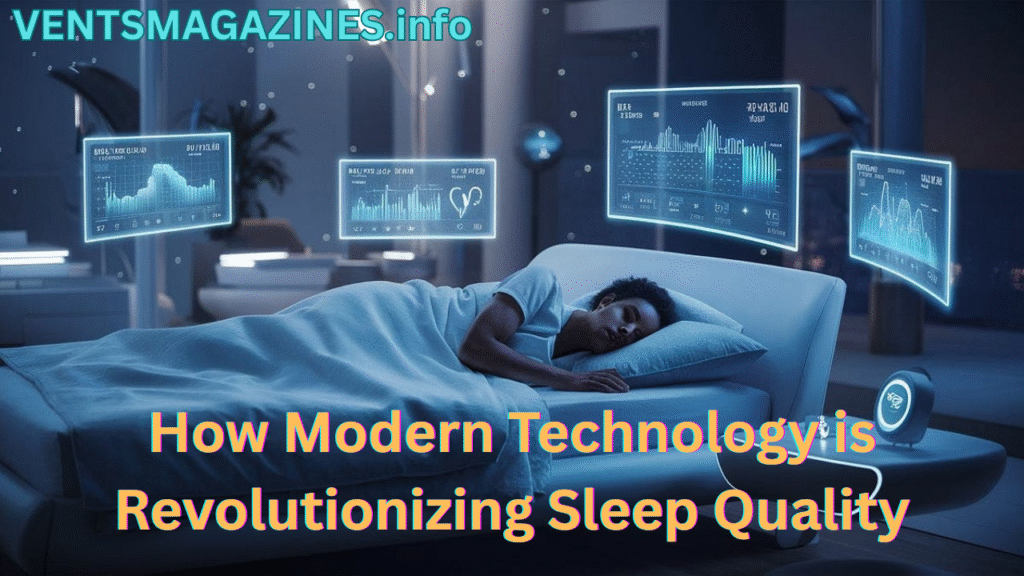1. Introduction
Sleep is one of the most crucial pillars of human health, alongside nutrition and exercise. Yet, in our fast-paced digital age, quality sleep is increasingly elusive. According to the World Health Organization, millions suffer from sleep disorders such as insomnia, sleep apnea, and restless leg syndrome. In response, technology is stepping in—not as a cause of sleep disruption, but as a potential solution.
From smart mattresses that adjust to your body’s needs to AI-powered apps that guide you into a restful state, modern technology is revolutionizing how we understand, monitor, and improve our sleep. This article explores the cutting-edge tools and innovations reshaping sleep quality worldwide.
2. Understanding Sleep Science
To understand how technology is improving sleep, we first need to understand sleep itself. Sleep isn’t just a passive state; it’s a dynamic biological process divided into several stages:
- Stage 1 (Light sleep): Transition between wakefulness and sleep.
- Stage 2: Deeper relaxation, preparing the body for restorative sleep.
- Stage 3 (Deep sleep): Physical healing, immune system strengthening.
- REM (Rapid Eye Movement): Dream phase, critical for memory and learning.
A full sleep cycle lasts about 90 minutes and repeats 4–6 times per night. Disruptions in this cycle can lead to fatigue, poor focus, mood disorders, and long-term health problems such as obesity, heart disease, and diabetes.
This is where technology becomes a game-changer—it can track, analyze, and even help regulate these stages.
3. Smart Sleep Trackers and Wearables
One of the most widely adopted tools in sleep tech is the wearable sleep tracker. Devices like the Apple Watch, Fitbit, Whoop, and Oura Ring use built-in sensors to collect biometric data while you sleep.
These wearables monitor:
- Heart rate variability (HRV)
- Sleep duration and quality
- Sleep stage detection (light, deep, REM)
- Blood oxygen levels and skin temperature
By syncing with mobile apps, they generate detailed sleep reports, showing trends and highlighting disturbances. Over time, this data can guide users toward healthier sleep routines, identify triggers for poor sleep (like late caffeine consumption), and even alert them to potential health issues.
4. AI-Powered Sleep Apps
Artificial Intelligence is now embedded in many sleep improvement tools. Apps such as Sleep Cycle, Pzizz, Headspace, and Calm use machine learning to personalize sleep experiences.
Features include:
- Smart alarms: Wake you at the optimal point in your sleep cycle
- Sleep coaching: AI recommends habits based on your sleep data
- CBT-I (Cognitive Behavioral Therapy for Insomnia): Delivered digitally to reduce anxiety around sleep
- Guided meditations and sleep stories: Help the mind unwind before bed
The most sophisticated of these apps integrate with wearables to form a closed feedback loop, improving with every night you sleep.
5. Smart Beds and Mattresses
Beds are no longer passive surfaces—they’re becoming intelligent companions in your sleep journey. Brands like Eight Sleep, Sleep Number, and Tempur-Pedic have introduced smart beds with innovative features:
- Temperature regulation: Cooling or heating zones for each side of the bed
- Automatic firmness adjustment: Based on sleep position or partner movement
- Sleep tracking sensors: Embedded in the mattress, requiring no wearable
- Vibration alarms: Wake you gently without disturbing your partner
These mattresses can dramatically improve comfort, reduce disturbances, and help ensure deeper sleep throughout the night.
6. Lighting Technology and Circadian Rhythms
The circadian rhythm is our internal biological clock, regulating the sleep-wake cycle based on light exposure. Artificial blue light—emitted from phones, tablets, and TVs—can trick our brains into thinking it’s still daytime, reducing melatonin production and delaying sleep.
To combat this, smart lighting solutions like Philips Hue, LIFX, and Wyze Bulbs have entered the market. These lights:
- Mimic natural sunrise and sunset
- Reduce blue light in the evening
- Support gradual dimming to signal bedtime
- Sync with sleep apps or smart speakers
Some even change light color based on the time of day, reinforcing healthy circadian patterns.
7. White Noise and Sleep Sound Devices
Sound is another powerful tool in promoting quality sleep. White noise, pink noise, brown noise, and nature sounds have all been shown to enhance deep sleep and reduce nighttime awakenings.
Devices and apps like:
- LectroFan
- Yoto Player
- Google Nest Hub
- myNoise and Rain Rain apps
…offer customizable soundscapes that mask disruptive noises like traffic or snoring. Some smart speakers also integrate these features and can be voice-activated for convenience.
8. The Role of Smart Home Integration
Modern sleep technology thrives when it becomes part of your broader smart home ecosystem. With systems like Google Home, Amazon Alexa, and Apple HomeKit, users can automate a personalized bedtime routine.
For example:
- At 10 PM, your smart home can dim lights, play soothing music, adjust the room temperature, and remind you to put away your phone.
- Motion sensors can detect when you’re in bed and turn off unnecessary electronics.
- Voice assistants can set alarms or play guided meditations without any physical input.
This hands-free experience reduces nighttime stress and promotes relaxation.
9. Emerging Sleep Innovations
Sleep technology continues to evolve rapidly. Some of the most cutting-edge tools include:
- EEG Headbands: Devices like Muse S or Dreem 2 monitor brainwaves in real-time and use biofeedback to help users fall asleep faster.
- Transcranial stimulation: Light electrical currents applied to the scalp can enhance deep sleep phases—though still under research.
- Contactless sleep sensors: Placed under your bed or mattress, these tools track breathing, movement, and heart rate without wearables.
- Sleep robots: Products like Somnox Sleep Robot simulate breathing to calm the user’s nervous system.
In the future, we may see personalized sleep medicine, using genetics and real-time health data to tailor sleep solutions for each individual.
10. Challenges and Ethical Considerations
While sleep technology offers incredible benefits, it also brings new concerns:
- Data privacy: Many devices collect sensitive biometric and behavioral data. Who owns it? How secure is it?
- Tech dependence: Overreliance on devices may increase anxiety if gadgets are unavailable.
- Affordability: High-end tech can cost hundreds or thousands of dollars—creating a digital divide.
- Accuracy: Not all consumer-grade devices are medically accurate, which could mislead users.
It’s essential to strike a balance between leveraging technology and nurturing natural, healthy sleep habits.
11. Conclusion
Technology is no longer just about keeping us connected—it’s helping us disconnect, rest, and recharge. From smart beds and wearables to lighting systems and AI apps, modern tools are transforming how we sleep.
However, while the innovations are exciting, the key lies in intentional usage. Use technology as an assistant, not a crutch. Support it with habits like a consistent bedtime, reduced caffeine, and screen-free evenings.


